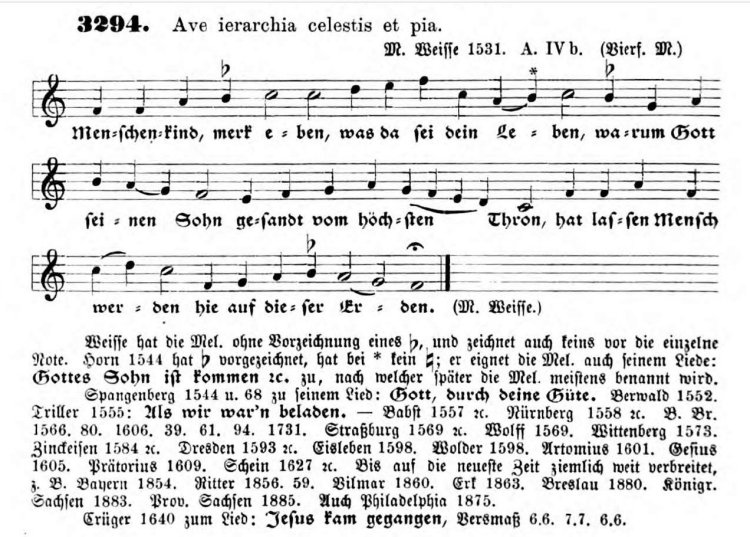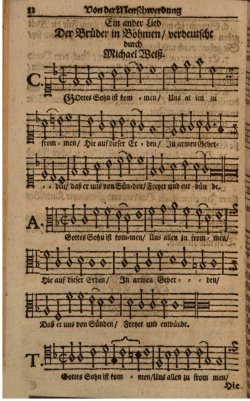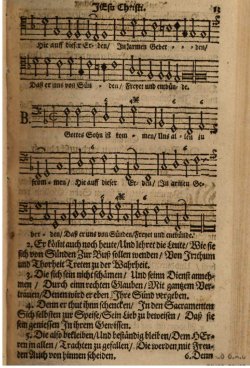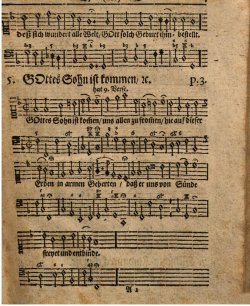|
|
Chorale Melodies used in Bach's Vocal Works
Menschenkind, merk oben |
|
Melody & Text | Use of the CM by Bach | Use of the CM by other composers |
| |
|
Melody & Text: |
|
NLGB No. 5, “Gottes Sohn ist kommen” (God’s Son is coming), 9 stanzas, Zahn melody 3294 also is set to the text “Menschenkind merk eben” (NLGB No. 6) and the alternate text, “Gott, durch deine Güte” (no NLGB, Johann Spangenberg 1544, three Trintarian stanzas for Advent (after the sermon), C.S. Terry English Translation. <<In the Orgelbüchlein [OB No. 2, BWV 600, https://www.youtube.com/watch?v=Lecc3wIMkOU] J.S. Bach attaches the titles of two hymns, Johann Roh’s “Gottes Sohn is kommen,” and Johann Spangenberg’s “Gott, durch deine Güte,” to a tune that originally belonged to neither of them, being that of the Latin hymn, Ave ierarchia Celestis et pia. Its earliest printed form is in Michael Weisse’s Ein Neu Gesengbuchlen (Jung Bunzlau, 1531), where it is set to M. Weisse’s hymn, “Menschenkind, merk eben.” In 1544, simultaneously but in different Hymn-books, J. Roh [Horn] and J. Spangenberg appropriated the tune to their respective hymns. “Johann Roh’s Christmas hymn, “Gottes Sohn ist kommen,” first appeared in the second German Hymn-book of the Bohemian Brethren (Ein Gesangbuch der Brüder inn Behemen und Merherrn), published at Nürnberg in 1544, with the tune (supra).” “Johann Spangenberg’s hymn (Gott, durch deine Güte) appears first among his Alte und Newe Geistliche Lieder und Lobgesenge, von der Geburt Christi unsers Herrn, Für die Junge Christen (Erfurt, 1544), with the melody. The hymn, accordingly, has Advent associations, though it is addressed to the Three Persons of the Trinity and directed to be sung after the Sermon.>>.
"The melody is the proper "Menschen, merk eben," later renamed for its association with the more successful hymn "Gottes Sohn ist kommen" [Zahn melody 3294],” says Matthew Carver, Hymnglyph, “a text (by Johann Roh) which did not appear until 1544. It was an adaptation by Michael Weisse of an ancient 12th century melody and was used for the first appearance of his hymn in his Bohemian Brethren Hymnal of 1531, where it is called "Ave Hierarchia." The full German texts of “Gottes Sohn ist kommen” and “Menschenkind merk eben,” side by side is found at Wikipedia, with biblical references: http://de.wikipedia.org/wiki/Gottes_Sohn_ist_kommen, scroll down to Text. "Gottes Sohn ist kommen is set as a plain chorale, BWV 318 (http://www.bach-chorales.com/BWV0318.htm, https://www.youtube.com/watch?v=0z84AeBbboA.
Source: Passiontide Devotional Chorales, Other Weiße Hymns (William L. Hoffman, February 20, 2018) |
|
Melody: Zahn 3294
Composer: Michael Weisse (Bohemian Brethren, 1501/1531), after an early church melody (Hohenfurt, 1410) |
 |
|
Text: Gottes Sohn ist kommen (NLGB 5; GH 5; EKG 2; EG 15; KELG 15)
Author: Johann Horn (Roh) |
|
Hymnal versions Bach may have known: |
|



|
|
Melody & text of Gottes Sohn ist kommen (NLGB 5) from the Neu Leipziger Gesangbuch, pp 12-14 |
|

|
|
Melody of Gottes Sohn ist kommen (GH 5) from the Psalmodia Sacra ( Gotha Hymnal, 1715), p 3 |
| |
| |
|
Use of the Chorale Melody by Bach: |
|
Text: Gottes Sohn ist kommen |
|
Chorale Gottes Sohn ist kommen, BWV 318
Ref: RE 18; Br 18; KE 115; Birnstiel 21; AmB 46II p.127 (down a M2); Levy–Mendelssohn 2; Fasch p.23; BGA 65; BC F143.1; CST 123 |
 |
|
Untexted: |
|
In the Orgelbüchlein J.S. Bach attaches the titles of two hymns, Johann Roh’s “Gottes Sohn ist kommen,” and Johann Spangenberg’s “Gott, durch deine Güte,” to a tune that originally belonged to neither of them, being that of the Latin hymn, “Ave ierarchia Celestis et pia.” Its earliest printed form is in Michael Weisse’s Ein New Gesengbuchlen (Jung Bunzlau, 1531), where it is set to M. Weisse’s hymn, “Menschenkind, merk eben.” In 1544, simultaneously but in different Hymn-books, J. Roh and J. Spangenberg appropriated the tune to their repective hymns.
J. Roh’s Christmas hymn, “Gottes Sohn ist kommen,” first appeared in the second German Hymn-book of the Bohemian Brethren (Ein Gesangbuch der Brüder inn Behemen und Merherrn), published at Nürnberg in 1544, with the tune (supra).
Johann Roh, by birth a Bohemian, styled himself “Cornu” in Latin, “Horn” in German. In 1518 he was appointed preacher to the community of the Bohemian Brethren at Jung Bunzlau and, in 1532, became Bishop. He died at Jung Bunzlau in 1547.
Johann Spangenberg’s hymn appears first among his Alte und Newe Geistliche Lieder und Lobgesenge, von der Geburt Christi unsers Herrn, Für die Junge Christen (Erfurt, 1544), with the melody. The hymn, accordingly, has Advent associations, though it is addressed to the Three Persons of the Trinity and directed to be sung after the Sermon.
J. Spangenberg was born at Hardegsen, Hanover, in 1484. After studying at Erfurt University he became preacher at Stolberg. In 1524 he was appointed pastor in St Blasius’ Church, Nordhausen, and thence in 1546 passed to Eisleben as Superintendent. He died there in 1550.
J.S. Bach uses the melody in the Organ movements infra, and Choralgesange, No. 115. His text is not invariable. In the Choralgesange he follows the 1531 text. In the Orgelbüchlein, where the sharpened fourth note of the melody is noticeable, he exactly follows Witt (No. 5), who substitutes B for F flat as the first note of the final phrase (supra). N. xviii. 42, on the other hand, agrees with the Choralgesänge text, the fourth line of the tune suffering some compression for metrical reasons.
The three Organ movements on the melody are in triple measure. J.S. Bach thereby enhances the appropriate resemblance between the Advent tune’s opening phrase and that of the Christmas Carol “In dulci jubilo.”
Source: Charles Sanford Terry: Johann Sebastian Bach, Bach’s Chorals, vol. 3 The Hymns and Hymn Melodies of the Organ Works [1921], pp 162-164 |
|
Chorale Prelude Gott, durch deine Güte, BWV 600 |
|
The Orgelbuchlein Advent movement bears the titles both of J. Roh’s and J. Spangenberg’s hymns. But J.S. Bach wrote it moved by the thought of redemption which J. Roh’s first stanza suggests. Hence the quaver joy rhythm. |
 |
|
Chorale Prelude Gottes Sohn ist kommen, BWV 703 |
|
Ashort Fughetta, among the miscellaneous Preludes, on the first line of the melody. Three mss. of it exist, one of them in the Kirnberger, another in the Voss, collection. |
 |
|
Chorale Prelude Gott, durch deine Güte (Gottes Sohn ist kommen), BWV 724 |
|
Spitta points out that the earliest form of Organ Choral, contrapuntal and without a fixed subject or episodic interludes, occurs in J.S. Bach’s use only in the present movement and “Vater unser im Himmelreich” (N. xix. 12). In both a few introductory bars imitate the first line of the melody. A copy of “Vater unser” (N. xix. 12) is among the Walther mss., a fact upon which Spitta concludes that it was written at Weimar. Probably the present movement must be assigned to the same period. The ms. of it is in Andreas Bach’s ms. Griepenkerl printed it for the Peters Edition from a copy “communicated by C. F. Becker.” |
 |
| |
| |
|
Use of the Chorale Melody by other composers: |
| |
| |
|
Sources: Bach Digital; BGA; Zahn; BCML discussions on BCW; Charles Sanford Terry's Bach Chorals books
Photos from Gottfried Vopelius: Neu Leipziger Gesangbuch (Vopelius 1682) & Christian Friedrich Witt: Psalmodia Sacra, Oder: Andächtige und schöne Gesänge… (Gotha Hymnal, 1715), were taken from digital copies of the books downloaded from Bayerische Staatsbibliothek München. These copies are Out of copyright - non commercial re-use (Europeana Rights).
Prepared by Aryeh Oron (October 2018) |
|
|